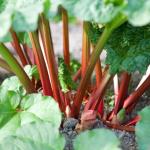Growing Rhubarb
Rheum rhabarbarum : Polygonaceae / the dock family
| Jan | Feb | Mar | Apr | May | Jun | Jul | Aug | Sep | Oct | Nov | Dec |
|---|---|---|---|---|---|---|---|---|---|---|---|
| P |
(Best months for growing Rhubarb in USA - Zone 5a regions)
- P = Plant crowns
- Easy to grow. Plant pieces of rhizome or roots 8 - 10 cm (3 - 4 in.) deep. Best planted at soil temperatures between 5°C and 20°C.
- Space plants: 90 cm apart
- Harvest in approximately 1 years. You will have a stronger plant if you leave it for about a year before using..
- Compatible with (can grow beside): Brassicas (Cabbage, Broccoli, Cauliflower, etc)
Rhubarb is easy to grow in cool climates and is a perennial. Rhubarb can be left in the ground and will return a crop for many years, at least 10 to 15 years (We have one that is more than 20 yrs old). Rhubarb is quite a hardy crop but the crown will rot if in heavy wet clay soils. It can cope with dry periods. Plant in good soil and remove as many weeds as possible. Do not disturb rhubarb roots when cultivating round the plant. Better in cooler climates, but can be grown in shady areas of warm climates. You can lift and divide rhubarb to make more plants. It is best to do this when the plant is dormant (or at least less actively growing) in winter or late autumn. It is best to wait until a plant is about 5 years old before dividing the crown but it can be moved at any age. Some of the root structure will be damaged when lifting it, so stalk production will not be so good for a few months. If you have mild winters and your rhubarb is still producing new stalks, you can continue to pick it. Although rhubarb is used in desserts and jams, it is considered a vegetable because the stalks are used not the fruit.
NB: Do not eat the leaves or roots as they contain oxalic acid which is poisonous. They should not be fed to poultry or stock either.
Remove flower stalks as they appear as the plant will stop producing leaf stalks when flowering.
Rhubarb can be 'forced' by covering dormant crowns with clay pots or a cloche in early spring.
Culinary hints - cooking and eating Rhubarb
Pick stems about the thickness of your finger. Large stems will have tough 'strings' down the length of them.
Use in pies, crumbles, fools and jams. Rhubarb goes well with orange.
Will usually need sweetener.



Your comments and tips